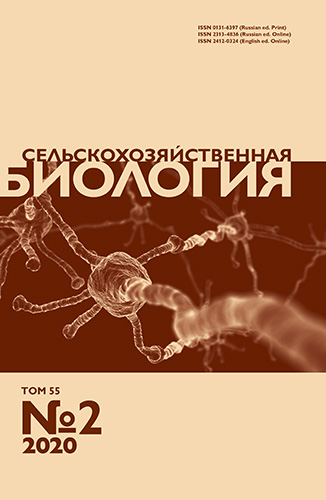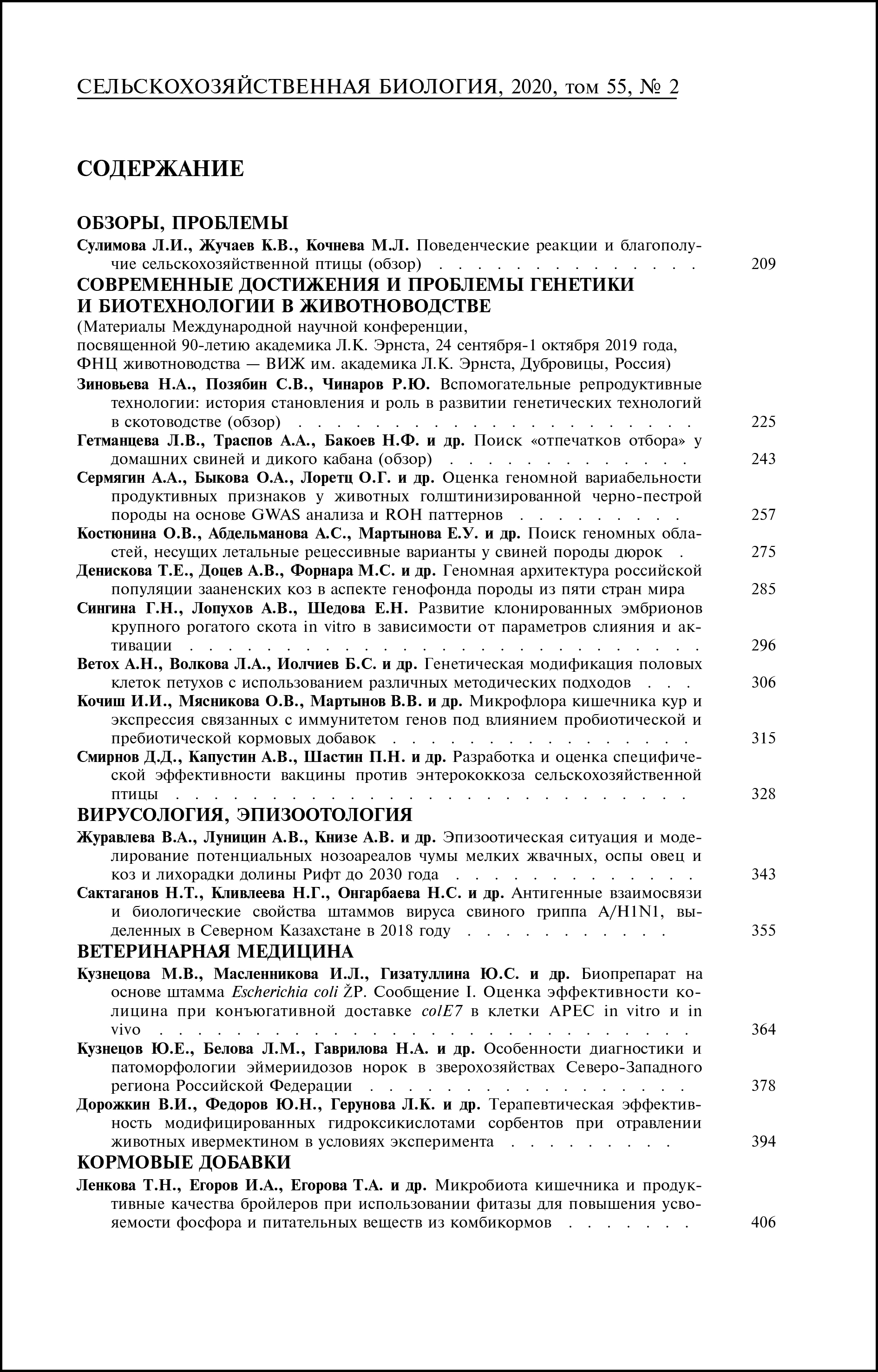doi: 10.15389/agrobiology.2020.2.378rus
УДК 636.934.57:619:616.993.192.1-07
ОСОБЕННОСТИ ДИАГНОСТИКИ И ПАТОМОРФОЛОГИИ ЭЙМЕРИИДОЗОВ НОРОК В ЗВЕРОХОЗЯЙСТВАХ СЕВЕРО-ЗАПАДНОГО РЕГИОНА РОССИЙСКОЙ ФЕДЕРАЦИИ
Ю.Е. КУЗНЕЦОВ1, Л.М. БЕЛОВА1, Н.А. ГАВРИЛОВА1, М.Э. МКРТЧЯН1,
К.В. СИДОРЕНКО1, А.Б. МУРОМЦЕВ2
Паразитарные болезни широко распространены у пушных зверей, особенно у норок. Кокцидиидозы занимают среди них особое место, поскольку часто протекают без выраженных симптомов и в ряде случаев несвоевременно диагностируются, причиняя при этом серьезный урон здоровью животных и нанося ощутимый экономический ущерб звероводческим хозяйствам. В представленной работе в звероводческих хозяйствах Северо-Западного региона РФ впервые была изучена паразитофауна, экстенсивность (ЭИ) и интенсивность инвазии (ИИ) норок, уточнен видовой состав эймериид молекулярно-генетическим методом, проведен анализ клинического и биохимического состава крови, а также патоморфологических изменений в кишечнике у больных эймериидозами животных. Впервые на территории Калининградской области был обнаружен вид Isospora еversmanni, а больных щенков норок удалось выявить с 13-суточного возраста. Даже при низкой ИИ у взрослых норок наблюдались патоморфологические изменения в тонком кишечнике. При высокой ИИ поражались все слои слизистой оболочки кишечника и отмечался выраженный диффузный, подострый лимфоплазмоцитарный энтерит. У больных норок были выявлены изменения в составе крови. Цель нашей работы заключалась в разработке комплексного подхода к диагностике эймериидозов норок, включающего изучение видового состава паразитирующих простейших, оценку экстенсивности и интенсивность инвазии, определение клинических и биохимических показателей крови здоровых и зараженных эймериидозами животных, а также установление патоморфологических изменений при эймериозе и изоспорозе, протекающих в хронической и бессимптомной форме. С 2013 по 2019 год в шести звероводческих хозяйствах Северо-Западного региона РФ (Ленинградская и Калининградская области) было обследовано 6118 зараженных эймериидами и интактных норок (Mustela vison, M. lutreola Linnaeus,1761, Neovison vison Schreber,1777). Их них 294 норки были исследованы прижизненными (клиническое исследование животных, морфологическое и биохимическое исследование крови) и посмертными (патологоанатомическое вскрытие норок после эвтаназии, гистологическое и иммуногистохимическое исследования) методами. По результатам паразитологических исследований возбудители эймериидозов были выявлены у 2687 животных (ЭИ — 43,92 %). Преобладающими видами простейших оказались Eimeria vison, Е. furonis, Isospora laidlawi и I. eversmanni. Было проведено глубокое секвенирование региона V4 гена 18S рДНК и биоинформатический анализ, позволивший определить ОТЕ (операционные таксономические единицы) и установить их таксономическую принадлежность. Так нам удалось подтвердить результаты световой микроскопии. При этом последовательность выделенного фрагмента E. vison длиной в 383 п.н. имела наибольшее сходство (99,48 %) с последовательностью другого вида E. ictideа, которую мы взяли из GenBank. Чаще всего эймериидозы норок протекали в виде моноинвазий (37,20 %), микстинвазия двумя паразитами встречалась в 6,15 %, микстинвазия тремя простейшими — в 0,57 % случаев. Пик ЭИ в Северо-Западном регионе РФ у молодняка и взрослых норок приходился на лето. У животных в возрасте 1,5-6 мес эймериоз и изоспороз протекал преимущественно в острой и подострой форме, у норок старше 6 мес — в подострой, хронической и латентной. Содержание гемоглобина и эритроцитов в крови у больных эймериидозами норок было достоверно ниже, чем у здоровых, количество лейкоцитов, напротив, увеличивалось. У больных животных также наблюдалась эозинофилия, сегментоядерная нейтрофилия, количество базофилов увеличивалось в 2 раза, палочкоядерных нейтрофилов — в 1,6 раза. У больных животных отмечалась протеинемия, содержание общего билирубина и креатинина повышалось соответственно на 33,83 и 31,90 %, количество мочевины снижалось на 21,19 %. При проведении иммуногистохимических исследований антигены вируса чумы плотоядных, коронавируса и алеутской болезни норок не были выявлены. Был обнаружен легкий эозинофильный и лимфоплазмоцитарный энтерит, сопровождающийся редким некрозом крипт вследствие паразитирования эндогенных стадий кокцидий. Заражение кокцидиями как в виде моноинвазии, так и ассоциаций паразитов сопровождалось нарушением целостности слизистой оболочки кишечника. При высокой ИИ в процесс полиморфной клеточной инфильтрации вовлекались как собственная и мышечная пластины, так и подслизистая основа. При этом возникал «синдром повышенной проницаемости кишечника», что сопровождалось нарушением функции желудочно-кишечного тракта.
Ключевые слова: норки, эймерии, изоспоры, простейшие, патогенез, патоморфология, гистология, иммуногистохимия.
Yu.E. Kuznetsov1, L.M. Belova1, N.A. Gavrilova1, M.E. Mkrtchyan1, K.V. Sidorenko1, А.B. Muromtsev2
Parasitic diseases are widespread in fur-bearing animals, especially in minks. Coccidiidoses occupy a special place among invasive diseases, as they often occur without any symptoms and in some cases are not timely diagnosed. Despite the mild clinical manifestation of invasion, it causes serious damage to animal health and significant economic damage to fur-bearing animal farms. The pathogenic effect of eimeriids on the body of fur-bearing animals consists of mechanical, toxic and inoculative effects. As a result, accumulations of mucus are found in the intestinal contents, sometimes with bloody patches. Subacute catarrhal hemorrhagic enteritis occurs, which is manifested by areas of hyperemia and edema of the mucous membrane of the small intestine, desquamation of the epithelium and is accompanied by a violation of the structure of the villi. In the presented work, in the fur bearing animal farms of the Northwestern region of the Russian Federation, the parasitic fauna, prevalence rates (PR) and invasion intensity (II) of minks were studied for the first time, the species composition of eimeriids was clarified by the molecular-genetic method, the clinical and biochemical composition of blood, as well as pathomorphological changes in intestines in animals with eimeriidosis were studied. Isospora eversmanni was discovered in the Kaliningrad region for the first time and we managed to discover ill mink puppies since 13 days of their age. Even with low II in adult minks, pathomorphological changes in the small intestine were observed. With high II, all layers of the intestinal mucosa were affected and marked diffuse, subacute lymphoplasmacytic enteritis was noted. In ill mink, changes in the composition of the blood were revealed. The objective of our work was to develop an integrated approach to the diagnosis of mink eimeriidosis, including the study of the species composition of parasitic protozoa, the assessment of PR and II, the determination of the clinical and biochemical blood parameters of healthy and eimeriids infected animals, and the establishment of pathomorphological changes typical for eimeriosis and isosporosis that occur in chronic and asymptomatic form. In total, from 2013 to 2019, 6118 minks (Mustela vison, M. lutreola Linnaeus,1761, Neovison vison Schreber,1777) were studied in six fur-bearing animal farms of the North-Western region of the Russian Federation using the coprological method. Of these, 294 minks were studied intravitally (clinical study of animals, morphological and biochemical blood tests) and postmortem (autopsia of minks after euthanasia, histological and immunohistochemical tests). At the same time, parasitic fauna was studied in six animal farms of the North-West region of the Russian Federation, 2687 of the examined minks were infected, the prevalence rates (PR) were 43.92 %. It was found that two species of eimeria parasitize in minks, Eimeria vison and E. furonis and two isospores, Isospora laidlawi and I. eversmanni. The latter species was discovered by us in the Kaliningrad region of the Russian Federation for the first time. A deep sequencing of the V4 region of the 18S rDNA gene and bioinformatics analysis were performed, which made it possible to determine OTUs (operational taxonomic units) and establish coccidia’s taxonomic affiliation. Thus we were able to confirm the results of light microscopy and determine the taxonomic affiliation of the isolated oocysts. As a result of the analysis, it was found that the sequence of the E. vison DNA fragment of 383 bp is most similar (99.48 %) to the sequence of another species (E. ictide) found in the GenBank. Data on high morphological and genetic similarities raise the question of the taxonomic affiliation of these two species and require additional detailed study. Most often, eimeriidoses of minks proceeded in the form of mono infections (37.20 %), mixed infections with two parasites were 6.15 %, mixed infections with three protozoans made 0.57 % of cases. The peak of PR in young and adult minks occurred in the summer in the Northwestern region of the Russian Federation. In animals aged 1.5-6 months, eimeriosis and isosporosis proceeded mainly in acute and subacute forms, in minks older than 6 months — in subacute, chronic and latent. The content of hemoglobin and red blood cells in the blood of ill mink with eimeriidosis was significantly lower than in healthy minks, while the number of leukocytes, on the contrary, increased. Eosinophilia, segmented neutrophilia were also observed in ill animals, the number of basophils increased by 2 times, the content of stab neutrophils increased by 1.6 times. Proteinemia was observed in ill animals, the total bilirubin and creatinine content increased by 33.83 and 31.90 %, respectively, and the amount of urea decreased by 21.19 %. A histological examination of material from various parts of the intestine from animals infected with eimeriids revealed that at a low intensity of invasion (II) (in adult minks), although the disease was not clinically manifested in this group of animals, nevertheless, pathological changes in the histological level have already been recorded in small areas and were noted mainly only in the epithelial plate of the intestinal mucosa. With high II, damage to all layers of the intestinal mucosa was observed. Pronounced diffuse, subacute lymphoplasmacytic enteritis was discovered. The pathological processes caused by the parasitism of eimeriid in minks are often similar to those for various infectious diseases, such as the carnivorous plague virus, Aleutian mink disease and coronavirus born disease. To exclude the possibility of diagnostic errors, the material was sent to the laboratory for immunohistochemical studies (IHC), as a result of which antigens of the carnivorous plague virus, coronavirus and Aleutian mink disease were not detected. Nucleic acids of viruses were not detected in all studied samples; the result of IHC was negative in all samples.
Keywords: mink, eimeria, isospora, protozoa, pathogenesis, pathomorphology, histology, immunohistochemistry.
1ФГБОУ ВПО Санкт-Петербургская государственная |
Поступила в редакцию |












